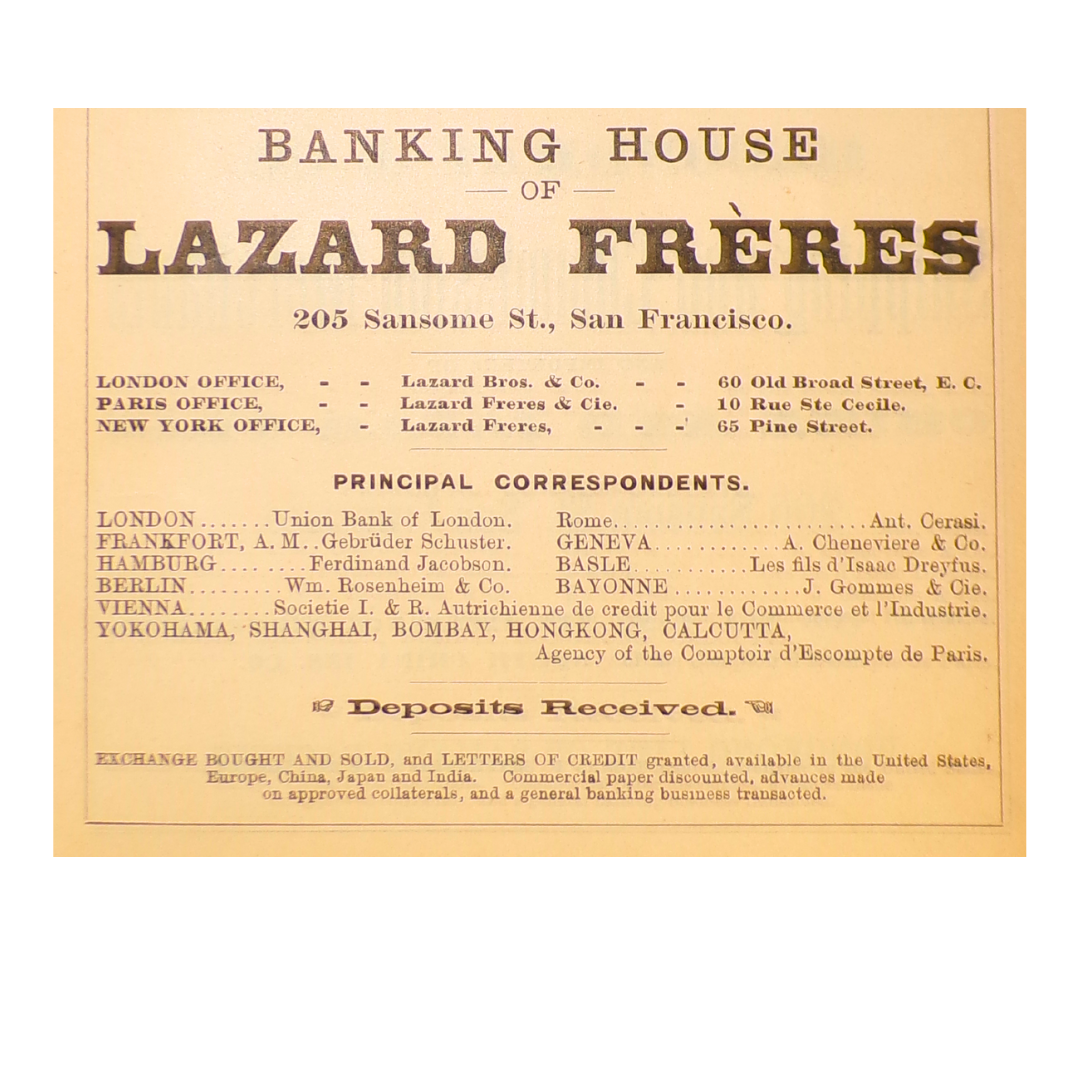Musée d’Histoire
de la Communauté Francophone
A glimpse into our different collections.
Learn more about the fascinating stories of French speaking immigrants from the Gold Rush to the Second World War.
Early Explorers
Before the Gold Rush, French-speaking explorers played a significant role in the early exploration of San Francisco and the Bay Area. In 1786, Jean-François de Galaup, Comte de La Pérouse, led a French expedition to the California coast, meticulously documenting the region's geography and indigenous cultures. Decades later, Jean-Jacques Vioget, a Swiss-born French-speaking surveyor and sea captain, created one of the earliest maps of Yerba Buena, the settlement that would later become San Francisco. Their contributions provide a vital record of the Bay Area before its transformation during the Gold Rush.
French settlers quickly established businesses, including bakeries, restaurants, and vineyards, contributing significantly to the city's economic and cultural development. The French Quarter in San Francisco emerged as a vibrant community, leaving a lasting legacy that remains evident in the city's identity today.
Get a sense of the different trades in the late 1880 to early 1900.
History of successes : famous department stores & restaurants
French-speaking immigrants left a lasting mark on San Francisco's culinary and commercial landscape through iconic establishments. The Old Poodle Dog, one of the city's earliest fine dining restaurants, introduced French cuisine to a growing cosmopolitan audience. The City of Paris department store, founded by the Verdier brothers, became a cornerstone of luxury shopping, renowned for its French imports and elegant atmosphere. Similarly, The White House department store catered to the city’s elite, offering high-quality goods and a distinctly Parisian shopping experience. These institutions embodied the entrepreneurial spirit and cultural refinement of San Francisco’s French community.
History of successes : Bankers & Investors
French-speaking bankers and investors played a pivotal role in the economic development of San Francisco during the 19th century. The Lazard brothers, originally from France, established a financial empire that began in San Francisco and later expanded globally. Entrepreneurs like F. L .A. Pioche and Antoine Borel contributed significantly to the city's growth by financing infrastructure projects, real estate developments, and industrial ventures. Their investments not only helped shape the physical and economic landscape of San Francisco but also solidified the city’s reputation as a hub for international commerce and opportunity.
The Gold Rush
During the California Gold Rush (1848–1855), San Francisco became a hub for French-speaking immigrants drawn by the promise of fortune. Thousands of French adventurers, known as "Les Argonautes," arrived to seek gold, bringing with them their culture, cuisine, and craftsmanship. This wave of emigration was fueled by economic instability and political upheaval in France and Europe, particularly following the Revolutions of 1848, which created widespread unemployment, social unrest, and a desire for new opportunities in distant lands like California.
Views of San Francisco
Our collection of lithographs offers a fascinating glimpse into how California was imagined and depicted during the 19th century. These vivid prints, often featured in books and magazines, shaped public perceptions of California for audiences in France and beyond. Romanticized scenes of sprawling landscapes, bustling goldfields, and thriving cities captivated readers and inspired dreams of adventure and prosperity. As one of the primary visual mediums of the time, these lithographs played a crucial role in promoting immigration, influencing countless individuals to embark on the journey to this faraway land of opportunity.
The community: local trades
Historical Context
This section of the exhibition explores the historical context that shaped waves of immigration between France and California. In California, the transition from Mexican to American rule in 1848, coinciding with the discovery of gold, opened new opportunities and drew global attention. In France, the Revolutions of 1848 and economic hardship spurred many to seek better prospects abroad. Advances in transportation, such as steamships and railroads, dramatically shortened travel times, making transcontinental and transatlantic journeys more accessible. These developments set the stage for the dynamic exchange of people, culture, and ideas that would transform both regions.
Gallery of portraits
The gallery of portraits celebrates influential members of San Francisco's French-speaking community who left a lasting impact on the city's development. Among them is Albert Pissis, a renowned architect who introduced the Beaux-Arts style to San Francisco, shaping its iconic urban landscape. Raphael Weil, a successful merchant and philanthropist, played a pivotal role in supporting charitable causes and cultural initiatives. These portraits honor their achievements and highlight the contributions of francophone leaders who helped build the vibrant, cosmopolitan city San Francisco is today.
Taking care of each other : French Hospital, Lafayette Hook and Ladder Company n°2 , French Clubs
This section of the museum highlights the vibrant community institutions established by French immigrants in San Francisco, showcasing their contributions to the city's cultural and social fabric. The French Hospital, one of the earliest healthcare facilities, provided vital services to the francophone population. The Lafayette Hook and Ladder Company, a volunteer fire brigade, exemplified their civic engagement. Notre Dame des Victoires Church became a spiritual and cultural hub for the community, while celebrations like Bastille Day brought French traditions to life in the city. Additionally, French clubs and societies fostered connections, offering spaces for camaraderie, cultural exchange, and support among immigrants, leaving a lasting legacy of unity and resilience.
From fires to earthquake: coming back from ashes
This part of the exhibit delves into the series of devastating fires that plagued San Francisco before the 1906 earthquake, including those that ravaged French-speaking neighborhoods and businesses. These early disasters tested the resilience of the community, with efforts like the Lafayette Hook and Ladder Company playing a critical role in firefighting. The Great Earthquake of 1906, however, was unparalleled in its destruction, leveling much of the city and leaving the French Quarter in ruins. This section highlights the perseverance and determination of the French-speaking community as they rebuilt and contributed to San Francisco's recovery and rebirth.



















